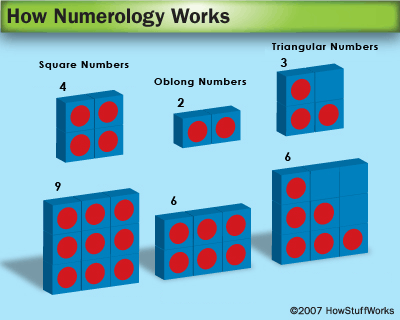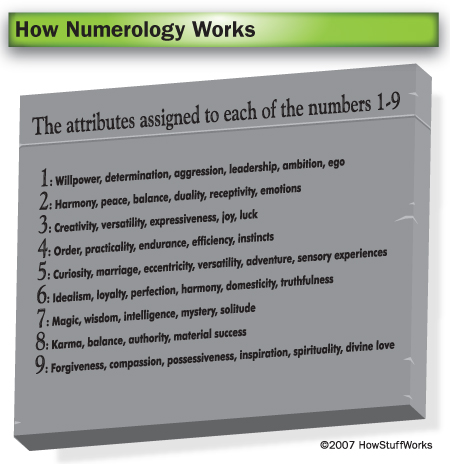
In the real world, arithmancy is known as numerology. According to numerologists, everything in the world is dependent upon the mystical properties of numbers. These properties come from the numbers' inherent vibration. Other new-age practitioners use the term vibration to describe beliefs in the power of items like crystals, gemstones, colors and essential oils. As the theory goes, each number has a unique vibration, giving it certain properties. These properties can shed light onto a person's behavior or predict whether romantic partners are compatible. Numerological analysis can determine a person's lucky number or lucky day. Recurring numbers can offer clues into how the world works or the significance of people and events. According to many numerologists, nothing happens by accident -- everything happens because of numbers.
In addition, Pythagoras and his followers believed in mystical properties of numbers. According to Underwood Dudley, author of "Numerology: Or What Pythagoras Wrought", the Pythagoreans became interested in number mysticism after discovering a particularly fascinating fact about numbers. If you add up a series of odd numbers beginning with the number one, the result is always a square number.
The Properties of NumbersIn their study of mathematical concepts, the Pythagoreans sorted numbers into categories. Numbers like 1, 4 and 9 were square because a corresponding number of dots or pebbles could be arranged in a perfect square. One, three, six and 10 were triangular -- one, three, six or 10 dots can be arranged into regular triangles. Two, six and 12 were oblong, since the corresponding number of pebbles formed rectangles.
Along with describing numbers in terms of math and geometry, the Pythagoreans also described them in terms of non-numerical traits. These traits had more to do with intuition and mysticism than science or mathematics. For example, odd numbers were masculine, and even numbers were feminine. The number one was creative, since the addition of multiple ones can create any other number. Two represented duality and was female, while three was male. As the sum of two and three, five represented marriage, and since it fell exactly in the middle of the numbers one through nine, it also represented justice. Ten was a sacred number, largely because it is the sum of the first four digits. The holiness of the number 10 led to a list of 10 fundamental opposites:
After the death of Pythagoras, interest in mathematical mysticism ebbed. It reappeared with the Neo-Pythagoreans around the first century A.D. Pythagoras' non-mathematical theories eventually faded. In the late 1800s, Mrs. L. Dow Balliett published several books on number vibration, music and colors. Other writers may have published work prior to Balliett, but her books seem to incorporate Pythagorean principles and add the concepts used in numerology today. According to Balliett and modern numerologists, each number has a specific vibration. People, foods, objects and colors also vibrate. In order to live a productive and harmonious life, people should make sure their environment vibrates in harmony with their own vibrations. This concept appears frequently in other new-age practices, some of which describe it as an affect of the movement of subatomic particles. However, there has been little scientific study to identify or quantify such a vibration or to analyze its affect on human existence. Some numerologists have also associated this vibration with the music of the spheres, or the sound Pythagoras believed the planets and the Sun made while orbiting the Earth. Pythagoras believed that the planets were embedded within transparent, physical spheres and that the distance between them corresponded to musical ratios. Science has since disproved both of those ideas, as well as the idea that the sun orbits the Earth. Unlike the Pythagoreans, modern numerologists apply numbers to people in addition to applying intangible concepts to numbers. According to most numerologists, the numbers one to nine have unique properties that are the direct result of their inherent vibration. Some of these properties come from Pythagorean writings, and others come from the way cultures around the world use and approach numbers. Different numerologists apply different attributes to numbers, but here's a run-down of some of the most popular.
Some systems also designate numbers with repeating digits as master numbers, which include all the attributes of two other numbers:
Numerology purports to tell the future, guide human behavior, predict the outcome of relationships and otherwise divine the unknowable by figuring out a person's numbers. For example, if the number nine has a particular vibration, a person whose number is nine has the same vibration. That person can choose what to eat, where to go and how to live based on which choices have a vibration that is compatible with nine. |
||





